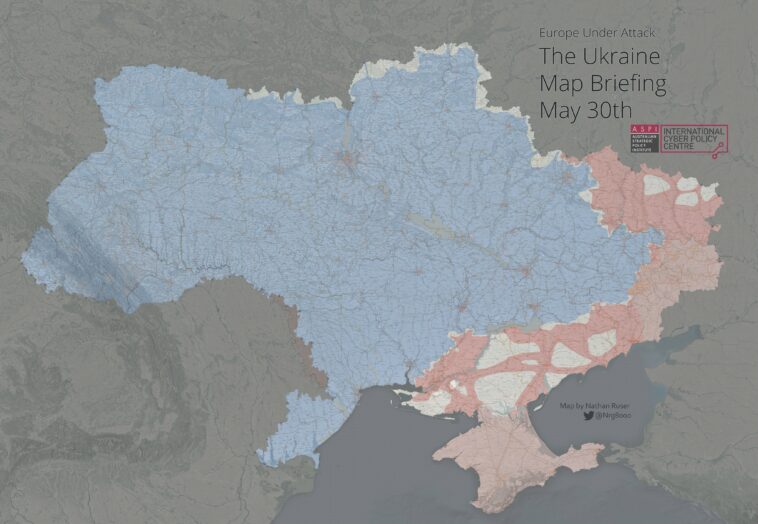Battle for Severodonetsk drains Russia’s main forces. Ukrainian troops counterattack in the south. In the battle for Severodonetsk, Russian progress in intense urban combat will likely be slow, a report by the Institute for the Study of War reads. Successful Ukrainian counterattacks in Kherson and Mykolayiv regions may force Russia to deploy reinforcements there, and additionally slow Russian efforts to consolidate administrative control of occupied southern Ukraine, analysts add.
The situation in Severodonetsk is difficult, there are street battles on the outskirts, Ukraine’s Defense Ministry said.
“In Severodonetsk, the situation is difficult, on the outskirts, street fighting rages. Ukrainian troops hold back Russia’s assault as Russia deploys more forces. Wherever they do not succeed, they retreat,” spokesperson of the Defense Ministry of Ukraine Oleksandr Motuzyanyk said. The situation is truly difficult, but the Ukrainian Armed Forces preserve control of it, he added.
“Intelligence works. We are aware of all enemy’s plans. Our aerial reconnaissance works. That’s why I have an optimistic view of the situation,” Motuzyanyk said.
“Russians entered the outskirts of Severodonetsk,” the head of the Luhansk regional military administration Serhiy Hayday said on May 30. “Two city residents were killed, and five were wounded on the northern-western and southern-eastern outskirts of the city. Most of them lived in the same block in the city’s old district. They were cooking outside when the shelling suddenly began,” he added.
Ukrainian counterattack in Kherson region. Ukraine went on counterattack against Russian forces in Kherson region, the General Staff of the Ukrainian Armed Forces said on the evening of May 28. Ukrainian troops pushed Russians back to “unfavorable positions,” the General Staff proceeded. The counterattack continued, the operational command “Pivden” (South) said on the morning of May 30.
“Ukrainian troops continue to advance. They block [Russia] from moving reserves,” the statement reads.
A Ukrainian counterattack in this direction was predictable, Austrian military analyst Tom Cooper said. On May 27 and May 28, the Ukrainian Armed Forces advanced 10 kilometers further to the south toward Kostromka village controlled by Russia’s 49th Combined Arms Army.
Opinions vary over the aim of Ukrainian counteroffensive in the north-east of Kherson region.
The Ukrainian counteroffensive has forced Russian troops to take up defensive positions and mass more troops in Kherson region, the Institute for the Study of War said in a report on May 29.
“This Ukrainian counterattack is likely intended to disrupt Russian efforts to establish strong defensive positions along the Southern Axis. While the Ukrainian counterattack does not appear likely to retake substantial territory in the near term, it will likely disrupt Russian operations and potentially force Russia to deploy reinforcements to the Kherson region, which is predominantly held by sub-standard units,” an ISW report reads.
Ukrainian counterattacks may additionally slow Russian efforts to consolidate administrative control of occupied southern Ukraine, analysts say.
Russian troops shell evacuation vehicle killing French journalist. Russian forces shelled an evacuation vehicle on its way to pick up 10 civilians, the head of the Luhansk regional military administration said. “Evacuation was halted. Russians hit a vehicle headed to evacuate people. A French journalist was killed. Today, an armored evacuation vehicle was on the way to evacuate 10 people from the area as it was struck by hostile fire. As shrapnel pierced the armored car, the French journalist carrying press credentials, was fatally wounded in the neck. He was on assignment documenting evacuation. A helmet saved the life of a patrol policeman,” Hayday said.
Ukraine in Flames #79: How Russia threatens the world with nuclear bluff
Russia is thought to have about 1,500 tactical nuclear warheads deployed on strategic long-range systems and almost 3,000 in reserve. The logistics to use these against Ukraine may have improved recently, as Belarusian leaderLukashenka allowed Russia to deploy nuclear-capable missiles on Belarusian territory near the Ukrainian border. Intelligence informs Russia’s nuclear missiles have not been prepared for launch at any time of the Russian aggression. Ukraine in Flames #79 shows how Russia’s threats to make effortless nuclear strikes across the globe are mere rhetoric to pressure the West into submission.
Speakers:
Viktor Yagun, Major General of the Security Service of Ukraine
Yuri Kostenko, Minister of Natural Environment Protection in 1992-1998
Oleksandr Kraiev, expert of the Foreign Policy Council of “Ukrainian Prism”
Mykhailo Samus, Deputy Director for International Affairs of the Center for Army Conversion and Disarmament Studies
Ukraine in Flames #80: Ecocide as an element of Russian war against Ukraine

